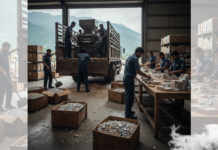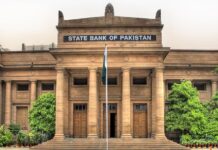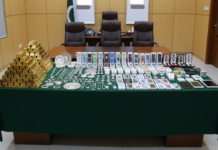If you are a small fashion retailer and have now grown big enough to want to open up a store in one of the prime locations of Lahore’s Gulberg area or a big mall, but need money for the expansion, what do you do?
Opening a new store at a prime location would require a very hefty investment, with months of rent in advance required to secure the lease. Then there are costs associated with building the store according to a certain design for a great customer experience but all your money is stuck in the inventory at your other stores and your savings wouldn’t cut it.
What do you do in such a scenario? If you are considering going to a Pakistani bank, good luck with securing a loan, if you do not have a collateral to provide as security against it. For a long time now, traditional commercial banks have had a very conservative stance on providing financing for retail. They would lend to small retailers for working capital requirements against their inventory, but they would not do it for expansion projects without a collateral as a security. The situation, however, could be different with the entry of digital banks in the scene, though some challenges await them as well.
Why don’t banks lend to retail businesses? The answer to this question has many facets. There is a dearth of data to assess credit in the case of small SMEs, there are risks associated with such lending due to how retail business cycles operate and then banks are plain lazy in some instances to do anything about it.
So you want to get a loan
“Retail businesses have to expand their footprint at a fast pace in line with the strength of its brand,” says Shamoon Sultan, CEO of the iconic Pakistani fashion brand, Khaadi. “Expansion means more capex and a higher level of money stuck in inventory which equates to more financing lines. Fast pace retail entities need financing support to meet their growth targets as organic growth is rather slow and gives an opportunity for competition to establish their base.”
The most rampant complaint that has come from banks as far as lending to small retail businesses is that because of the severe lack of documentation of the economy, banks do not have enough, let alone good, data points to build risk models on and lend to these customers. About 80% of retail in Pakistan is undocumented mostly because of the fears of coming into the tax net and the burdens that come with that, constraining their growth in the process.
As a consequence, retail financing has been restricted to financing for working capital requirements of small businesses, but at a small scale. Bilal Amjad Khan, head of supply chain financing at Bank Alfalah, says that his bank is very active in extending loans to small businesses.
“Retailers are the growth engines in the economy and they have working capital constraints. They are also connected with big corporates one way or the other which makes it easier to lend to them,” he says.
Working capital financing helps retailers with their day to day operations and when they hit a point where they require big sums of money to invest into growth, banks start getting wary. A multitude of factors come into play here.
Khan explains candidly that with respect to expansion projects, the general sentiment in the industry is that banks would not do such financing and the associated challenge is the aspect of documentation that these retailers do not have.
“If you look at it from a bank’s perspective, retailers are not eligible for these loans if they do not have the required transparency in their business, even if the business is worth billions of rupees,” says Khan.
“On the small merchant side, there is a dearth of such data because of their own unwillingness to document such data or simply the lack of awareness to do so. The challenge for banks then is what do they create their risk engine against and how do they measure the credit worthiness, or assess the risk of a small merchant or an SME in the absence of such data,” says a former banker.
Some of the challenges faced by banks in assessing the credit worthiness of a small merchant is the level of financial detail required for such lending, the lack of adequate and reliable timelines and other requirements such as reporting and going through an audit. Auditing has its own challenges in Pakistan.
At a bigger scale, securing financing from banks has almost exclusively been a luxury for big corporations with multiple business segments. For instance brands like Gul Ahmed, AlKaram and Sapphire would be able to readily get financing from banks for the retail business. Banks already have established banking relationships with Gul Ahmed, AlKaram and the likes, and financing for their retail operations becomes easy because it is just an extension of their other businesses.
These big retailers have access to credit lines from banks because of the visibility of the latter on their other business segments. Most of the prominent brands in fashion retail are backed by legacy businesses. For instance, Sapphire retail is backed by Sapphire Group. Both AlKaram and Gul Ahmed are big textile exporters and SanaSafinaz has the backing of Hashoo Group. Because the banks have decades old business relationships with these groups, they also have strong visibility on their financial strength.
Some of these textile manufacturers are export oriented and avail export subsidy schemes mandated by the government.
Most of the fashion brands that are the most prominent in this segment, are backed by legacy businesses. “In the case of Gul Ahmed for instance, you can pull out how much cotton yarn they purchased, what were the input prices and what was their production. With the availability of such data, banks are more willing to lend, and financing becomes less risky,” said a former banker commenting anonymously.
“It is easier for big retailers to get financing as the brand value is considerably higher and they can also get better credit terms from their suppliers. Small brands have a smaller footprint and their financials may not be as strong so banks do not give them priority,” says Sultan.
“Banks in Pakistan still rely on tangible security in the form of plant and machinery or land and building. Since most of the stores of retail businesses are in rented premises primarily in shopping malls, the retail sector has no immovable property to mortgage. Internationally, financing is given to retail businesses on the basis of their cash flows so as they grow they also get more loans, which can be further used for expansion.”
It is, however, not entirely the case of being part of a big business group to be able to secure financing. Brands all around the world are able to get financing for expansion without being part of any big business group. In Pakistan, however, despite being a big brand, there are certain aspects of the business that make the banks wary of lending to retail businesses.
Here’s why you wouldn’t get a loan
The way big retail brands like Khaadi or say Beechtree operate is that they are not manufacturers themselves and would have to order inventory for a certain sales cycle months before the sales start to ensure there are no untimely disruptions in sales.
For instance if Beechtree has to put up a winter collection for sale, ordering for that would start with the manufacturer months before; say eight months. Then the company would require another two to three months before the inventory is completely liquidated at stores. The entire cash conversion cycle could run up to a year, increasing the chances of a cash flow crunch in business and raising a need for financing.
The need for financing would be higher because orders for the next collection, say the Summer collection, would have to be placed with the manufacturers when orders from the previous inventory wouldn’t have been liquidated. In effect, the company would have to raise funds for two batches.
The amounts needed for financing would be further increased by the growth targets of a retail brand. Pakistani retail brands have witnessed unprecedented growth in the periods before Covid. Individual growth targets mean that if Khaadi has to start ordering its new winter collection with one or more than one manufacturer, it would also account for the growth that it expects or has set for itself.
According to sources in the industry, Khaadi had sales worth Rs 21 billion last year. So for instance, if Khaadi wants to increase its sales to Rs 30 billion 2022, it would need more cash to achieve the higher target, effectively increasing the amount of funds required from a bank. As long as the growth trajectory of a brand is higher than its profits, it will need more money for financing.
Some, if not all, of this growth would be coming at the cost of discounting and the brand might not even be profitable. The thought process of Pakistani corporate bankers would be such that if a brand does not have the ability to generate profits, how would it be able to return the loan? In fact, it would need to have enough profits to be able to continue its growth and return money to the lenders, raising questions about the viability of the business.
It simply makes a risky investment for a bank and they would require collateral, like a factory for example, to protect themselves in case of a downside. While the inventory itself is also a security which the bank can sell in case a brand fails, it cannot be in its possession because it needs to be sold for the brand to be able to pay its liabilities back to lenders.
The problem with such an arrangement is that inventory could be spread across multiple stores and could be so big in volume that it wouldn’t be possible for the bankers and even auditors to reliably assess the volume of stock. As a matter of fact, the exact issue arose in the case of Hascol whose auditors were not able to accurately assess the inventory of fuel and banks extended loans of an amount higher than the available inventory.
A similar issue could arise in the case of retailers as well. That since the inventory is not in the possession of the banks because that is what needs to be sold to repay the debt to the bank, and that if it is at the stores, it can not be counted reliably, instances of miscalculations if not fraud become more plausible. Banks could lend more than the inventory or interchangeably, when it’s time for the bank to liquidate the inventory, the bank might find that the inventory was not what the brand claimed it was.
In some other instances, brands have misdeclared their sales to the banks for securing financing, while reporting different numbers to the FBR for the purpose of avoiding taxes, prompting banks to deny financing to such businesses. All of this makes it a risky business to lend to retail brands without a collateral and banks prefer resorting to safer pastures such as lending to the government or big corporates.
As a consequence, big brands that are not part of a conglomerate and don’t have a collateral to give as security, run the risk of going to predatory loan sharks which ask for exorbitant returns that can kill a business altogether.
Financing for small retailers
At least the bigger brands have greater transparency in their financials. It is in the case of small retailers that the dearth of data does not let banks to adequately calculate cash flows and decreases future predictability. The banks then consider this risk that if a loan is approved for a smaller merchant, even if it is a small amount, it could go to other avenues such as real estate assets.
This explanation with respect to the lack of data to lend to small retail businesses that want to grow further falls short of being the truth. The fact of the matter is that even without the availability of a great dataset for credit assessment, unconventional methods of assessing credit by corporate finance teams of these banks can be employed.
A former banker, on the condition of anonymity, explains that both revenue and inventory financing for retail in Pakistan is lacklustre because banks are unwilling to put a lot of effort into developing models that are unconventional in nature but would promote better access to finance for retailers. Banks wouldn’t make the effort to build such models simply because for them, the easiest way to mobilise their deposits towards lending without doing anything is to lend to the government risk free.
“They’d rather engage their capital towards something where they do not have to put in a lot of effort. Because of the idea of lending conventionally in Pakistan, banks haven’t made the effort to come up with non-conventional means to assess an SME’s creditworthiness. They would evaluate the SME at the criteria they would evaluate a corporate client but the data a corporate client can provide, an SME cannot and that is why corporate bankers complain about not having enough data points to understand a small retailer’s business,” the banker explained.
“An SME is not an SME. There are several different verticals and several businesses and the data available and the kind of data required to truly assess an SMEs credit worthiness, differs from vertical to vertical. That means they would have to create a model for each of these verticals which requires investment and understanding of the vertical and banks don’t have that kind of inclination to do so,” he added.
This is not to say that growth of retail businesses solely depends on the easy availability of financing from the banks. There are a multitude of factors that affect the growth of retail in Pakistan and access to finance is just one of them. Even with easy access to financing, argues Sultan, there may be other barriers to brand growth in Pakistan.
“For example, the country’s market may be highly competitive, with many other brands offering similar products and services. In this case, it may be difficult for a brand to differentiate itself and gain a significant market share,” he adds.
“Additionally, factors such as political instability, economic instability, and other challenges may also impact a brand’s ability to grow. Overall, while financing can certainly play a role in helping brands grow, there are many other factors that can influence the potential for growth.”
The case that we are making here is that a set of interconnected issues hinders the growth of retail, and in some instances one causes the other. To avoid the burden of taxation, retailers stay undocumented, which creates obscurity for banks. Digital payments, which can in part help create transparency, are caused by taxes and charges such as the MDR.
On providing loans to retailers, while banks have a legitimate issue with regards to transparency of data for assessing credit and lack of trust, they haven’t been very active on following unconventional models for lending.
A source in the banking industry, with over 20 years of experience in banking, argues that specifically to solve the problem of financing for SMEs such as small retailers, the SME Bank was created by the federal government. The SME Bank was formed as a public limited company under the Companies Ordinance 1984, with the Government of Pakistan as the major shareholder.
As part of the financial sector restructuring programme of the Government of Pakistan, Regional Development Finance Corporation (RDFC) and small Business Finance Corporation (SBFC) were amalgamated into SME Bank Ltd at the beginning of 2002.
The source claimed that for the last five years, the SME Bank has been practically dysfunctional. And that it is, perhaps, the only bank that has less than 20,000 customers, he claimed. Unless the SME Bank is revived access to credit will be a problem for small and medium retailers.
What could be the solution, meanwhile? While the ability to lend big amounts to big brands belongs only with banks right now, scores of startups have emerged recently that are focused on digitisation of SMEs for lending to them. For instance in grocery retail, to collect that data and create that transparency in their transactions, startups like SnappRetail and Aladdin Informatics are on an arguably ruthless journey to digitise grocery retailers and create that repository of data on which banks would also be able to lend. On the other hand, fintech startup PostEx works with small merchants to help them with improving their cash flows by paying invoice value upfront for COD orders.
A new legion of digital-only banks are also about to take roots in the Pakistani market which would have to target small SMEs for lending purposes. They will be faced with numerous challenges, though. Digital banks wouldn’t have a great opportunity to raise deposits since wealthy depositors are all with commercial banks at the moment. Furthermore, digital banks would have to face similar challenges that commercial banks currently do. They would have to come up with innovative models for risk assessment for which the challenge of accurate data exists, just like it does for banks. It remains to be seen how unconventional they can get.

























Very well written and a good read targeting this issue
My husband and I are another successful client of Cyber Genie Intercontinental among many. I read countless positive reviews about how they have been using their cyber expertise to help people achieve their happiness back by recovering their scammed or lost Bitcoin and assets from fraudulent and posers of Cryptocurrencies trading companies. After reading many of the wonderful services they render, I had to contact them because my husband was seriously defrauded by some Chinese bitcoin miners, it all ended in goodwill as we were able to recover what we thought we had lost to scammers. Contact them on [ Cybergenie AT cyberservices DOT com ] WHATSAPP [ +1 ] 2.5.2-5,1,2-0.3,9.1 ] and help yourself from depression.
Banks take collateral, assign a financing limit much less than the actual market value of collateral, then apply high cash margins against financing amount due to which one can barely avail financing equivalent to 40-60% of collateral value. This is utterly nonsensical behavior by the banks who’s risk departments only exist to make sure all collateral based financing is done 200% risk free.
It is amusing to note that politician-cum-businessmen and their cabal can avail billions in loans and default on it without significant repercussions while genuine businesses needing a few million cannot even get reasonable loan terms without having a collateral of twice the financing value.
SMEs are the backbone of employment and economy and keep being treated like trash by the government and its shark departments always out for more blood and taxes.